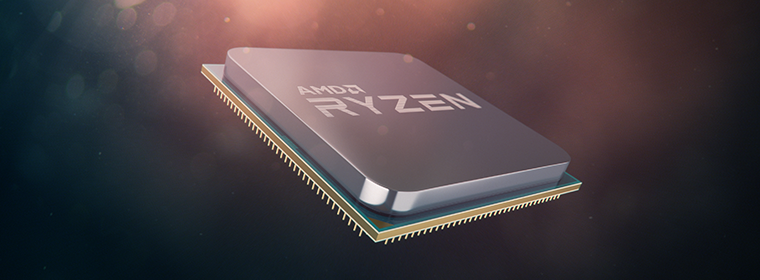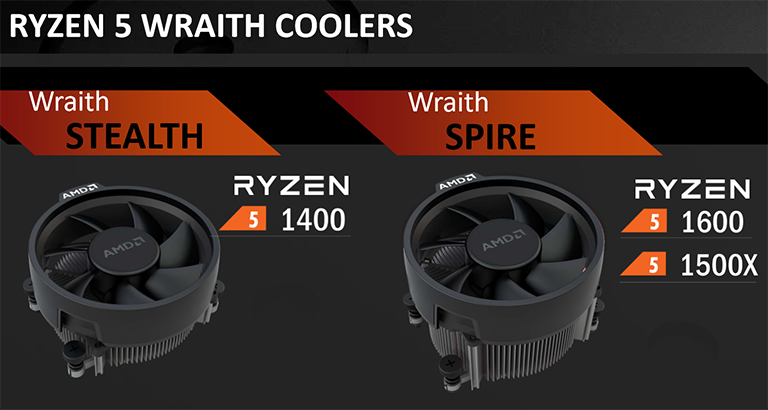
The dust has just about settled enough on the Ryzen 7 launch for AMD to announce a quartet of further CPUs at lower price levels. Enter the Ryzen 5.
AMD vs. Intel: desktop CPUs |
|||||||||
|---|---|---|---|---|---|---|---|---|---|
| Model | Cores / Threads |
TDP |
L3 Cache |
Base Clock |
Turbo Clock |
XFR |
Memory |
Package |
Price |
| AMD Ryzen 7 1800X | 8 / 16 |
95W |
16MB |
3.6GHz |
4.0GHz |
100MHz |
DDR4-2666 |
AM4 |
$499 |
| AMD Ryzen 7 1700X | 8 / 16 |
95W |
16MB |
3.4GHz |
3.8GHz |
100MHz |
DDR4-2666 |
AM4 |
$399 |
| AMD Ryzen 7 1700 | 8 / 16 |
65W |
16MB |
3.0GHz |
3.7GHz |
50MHz |
DDR4-2666 |
AM4 |
$329 |
| AMD Ryzen 5 1600X | 6 / 12 |
95W |
16MB |
3.6GHz |
4.0GHz |
100MHz |
DDR4-2666 |
AM4 |
$249 |
| AMD Ryzen 5 1600 | 6 / 12 |
65W |
16MB |
3.2GHz |
3.6GHz |
100MHz |
DDR4-2666 |
AM4 |
$219 |
| AMD Ryzen 5 1500X | 4 / 8 |
65W |
8MB |
3.5GHz |
3.7GHz |
200MHz |
DDR4-2666 |
AM4 |
$189 |
| AMD Ryzen 5 1400 | 4 / 8 |
65W |
8MB |
3.2GHz |
3.4GHz |
50MHz |
DDR4-2666 |
AM4 |
$169 |
On April 11, AMD will bring to bear the Ryzen 5 1400, 1500X, 1600 and 1600X. A key difference between these chips and the range toppers is the marketing choice to split Ryzen 5 into four- and six-core models.
Ryzen 5 1400 and 1500X will both use the established four-core, eight-thread architecture common on current Intel chips. As we already know all Ryzen chips are unlocked, the pair are split on base and boost frequencies, with R5 1400 chiming in at 3.2GHz base and 3.4GHz boost while 1500X increases this to 3.5GHz and 3.7GHz, respectively. What AMD is not disclosing know is exactly how these Ryzen 5 chips are built from a CCX point of view, though it would make sense that the four-core part is one CCX paired with 8MB of L3 cache.
All but the R5 1600 X will arrive at retail with coolers in the box. You may have heard of AMD releasing a slew of new heatsinks alongside the Ryzen launch, so the R5 1400 gets the Wraith Stealth while R5 1500X and R5 1600 receive the beefier Spire.
We'd argue it is far more important for AMD's bottom line to ensure that Ryzen 5 is successful against a host of Intel chips - each company will undoubtedly sell more of these than $300-plus models.
With that in mind, here is how the quarter line up against the price equivalent chips from Intel's current Kaby Lake stable.
AMD vs. Intel price comparison |
|||||||||
|---|---|---|---|---|---|---|---|---|---|
| AMD | Price |
Intel |
|||||||
| AMD Ryzen 5 1600X (6 / 12) | $249/$243 |
Intel Core i5-7600K (4 / 4) |
|||||||
| AMD Ryzen 5 1600 (6 / 12) | $219/$213 |
Intel Core i5-7600T (4 / 4) |
|||||||
| AMD Ryzen 5 1500X (4 / 8) | $189/$192 |
Intel Core i5-7500 (4 / 4) |
|||||||
| AMD Ryzen 5 1400 (4 / 8) | $169/$168 |
Intel Core i3-7350K (2/4) |
|||||||
AMD offers more threads at each price point, replicating what Ryzen 7 has done at the higher end of the spectrum. Gaming performance is still up in the air, especially as each chip is using SMT, so we will only have a truer picture once the chips are benchmarked and reviewed.
Until then, has Ryzen 5 piqued your interest enough?
Update: 11:00
AMD has confirmed that all Ryzen 5 CPUs are Ryzen 7 chips that have been symmetrically disabled, so 3+3 across two CCXes for the six-core part, and 2+2 across the same two CCXes for the four-core part.
As they are based on the Ryzen 7, AMD has chosen to imbue the six-core part with the full 16MB L3 cache whilst the four-core part gets 8MB.














